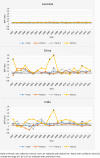Sex ratios at birth in Australia according to mother's country of birth: A national study of all 5 614 847 reported live births 1997-2016
- PMID: 34170929
- PMCID: PMC8232452
- DOI: 10.1371/journal.pone.0251588
Sex ratios at birth in Australia according to mother's country of birth: A national study of all 5 614 847 reported live births 1997-2016
Abstract
Objectives: Son preference and sex selective practices have resulted in a deficit of girls in several countries, primarily across Asia. Emerging evidence indicates that son preference survives migration to Western high-income countries. The objective of this study was to assess male-to-female (M/F) ratios at birth per mother's country of birth in Australia 1997-2016, in total and by parity, and by states/territories and over time.
Methods: Data for this national population-based cross-sectional study were obtained from the National Perinatal Data Collection (NPDC) and included all live births in Australia 1997-2016 (N = 5 614 847). M/F ratios with 95% Confidence Intervals were estimated.
Results: The M/F ratio for births to Australian-born mothers was within the expected range (1.03-1.07) regardless of parity and time period. M/F ratios were elevated above the expected range for births to mothers born in China in the total sample (M/F ratio 1.084, 95% confidence interval 1.071-1.097) and at parity 2 (1.175, 1.120-1.231), and for births to mothers born in India at parity 2 (1.146, 1.090-1.204). Parity 2 births were the most consistently male-biased across time. Across states, elevated M/F ratios were identified for both groups in New South Wales (China parity 2: 1.182, 1.108-1.260; India parity 2: 1.182, 1.088-1.285), for births to Chinese-born mothers in Victoria (total births: 1.097, 1.072-1.123; parity 1: 1.115, 1.072-1.159) and Australian Capital Territory (total births: 1.189, 1.085-1.302) and births to Indian-born mothers Western Australia (parity 2: 1.307, 1.122-1.523).
Conclusions: Son preference persists in some immigrant communities after migration to Australia. The consistent pattern of elevated M/F ratios across the larger states indicates that sex imbalances at birth are largely independent of restrictiveness of local abortion laws. Drivers and consequences of son preference in Western high-income settings should be explored to further promote gender equality, and to strengthen support for women who may be vulnerable to reproductive coercion.
Conflict of interest statement
The authors have declared that no competing interests exist.
Figures
Similar articles
-
Male-biased sex ratios in Australian migrant populations: a population-based study of 1 191 250 births 1999-2015.Int J Epidemiol. 2018 Dec 1;47(6):2025-2037. doi: 10.1093/ije/dyy148. Int J Epidemiol. 2018. PMID: 30052991 Free PMC article.
-
Sex ratios among Canadian liveborn infants of mothers from different countries.CMAJ. 2012 Jun 12;184(9):E492-6. doi: 10.1503/cmaj.120165. Epub 2012 Apr 16. CMAJ. 2012. PMID: 22508977 Free PMC article.
-
Reproductive pattern, perinatal mortality, and sex preference in rural Tamil Nadu, south India: community based, cross sectional study.BMJ. 1997 May 24;314(7093):1521-4. doi: 10.1136/bmj.314.7093.1521. BMJ. 1997. PMID: 9169399 Free PMC article.
-
A scoping review of female disadvantage in health care use among very young children of immigrant families.Soc Sci Med. 2016 Mar;152:50-60. doi: 10.1016/j.socscimed.2016.01.027. Epub 2016 Jan 19. Soc Sci Med. 2016. PMID: 26840770
-
Cultural and Social Bias Leading to Prenatal Sex Selection: India Perspective.Front Glob Womens Health. 2022 Jun 13;3:903930. doi: 10.3389/fgwh.2022.903930. eCollection 2022. Front Glob Womens Health. 2022. PMID: 35769211 Free PMC article. Review.
Cited by
-
Indirect evidence of sex-selective abortion practices to the imbalanced sex ratio at birth in Australian migrant populations.PLOS Glob Public Health. 2025 May 28;5(5):e0004672. doi: 10.1371/journal.pgph.0004672. eCollection 2025. PLOS Glob Public Health. 2025. PMID: 40435191 Free PMC article.
-
Trends in female-selective abortion among Asian diasporas in the United States, United Kingdom, Canada and Australia.Elife. 2022 Sep 27;11:e79853. doi: 10.7554/eLife.79853. Elife. 2022. PMID: 36165452 Free PMC article.
-
Skewed Sex Ratios at Birth in Italian Migrant Populations: Evidence from a Longitudinal Register 1999-2017.Eur J Popul. 2022 Mar 4;38(2):301-315. doi: 10.1007/s10680-022-09612-9. eCollection 2022 May. Eur J Popul. 2022. PMID: 35619743 Free PMC article.
References
-
- UNFPA (United Nations Population Fund). Sex Imbalances at Birth: Current trends, consequences and policy implications. Bangkok: UNFPA Asia and the Pacific Regional Office; 2012.
-
- Bongaarts J, Guilmoto CZ. How many more missing women? Excess female mortality and prenatal sex selection, 1970–2050. Popul Dev Rev. 2015;41(2):241–69.
-
- Almond D, Edlund L, Milligan K. Son Preference and the Persistence of Culture: Evidence from South and East Asian Immigrants to Canada. Popul Dev Rev. 2013;39(1):75–95.
Publication types
MeSH terms
LinkOut - more resources
Full Text Sources



